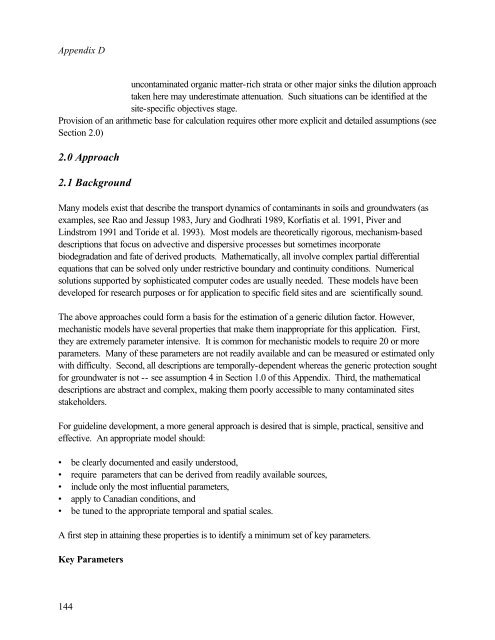Protocol for the Derivation of Environmental and Human ... - CCME
Protocol for the Derivation of Environmental and Human ... - CCME
Protocol for the Derivation of Environmental and Human ... - CCME
You also want an ePaper? Increase the reach of your titles
YUMPU automatically turns print PDFs into web optimized ePapers that Google loves.
Appendix D<br />
uncontaminated organic matter-rich strata or o<strong>the</strong>r major sinks <strong>the</strong> dilution approach<br />
taken here may underestimate attenuation. Such situations can be identified at <strong>the</strong><br />
site-specific objectives stage.<br />
Provision <strong>of</strong> an arithmetic base <strong>for</strong> calculation requires o<strong>the</strong>r more explicit <strong>and</strong> detailed assumptions (see<br />
Section 2.0)<br />
2.0 Approach<br />
2.1 Background<br />
Many models exist that describe <strong>the</strong> transport dynamics <strong>of</strong> contaminants in soils <strong>and</strong> groundwaters (as<br />
examples, see Rao <strong>and</strong> Jessup 1983, Jury <strong>and</strong> Godhrati 1989, Korfiatis et al. 1991, Piver <strong>and</strong><br />
Lindstrom 1991 <strong>and</strong> Toride et al. 1993). Most models are <strong>the</strong>oretically rigorous, mechanism-based<br />
descriptions that focus on advective <strong>and</strong> dispersive processes but sometimes incorporate<br />
biodegradation <strong>and</strong> fate <strong>of</strong> derived products. Ma<strong>the</strong>matically, all involve complex partial differential<br />
equations that can be solved only under restrictive boundary <strong>and</strong> continuity conditions. Numerical<br />
solutions supported by sophisticated computer codes are usually needed. These models have been<br />
developed <strong>for</strong> research purposes or <strong>for</strong> application to specific field sites <strong>and</strong> are scientifically sound.<br />
The above approaches could <strong>for</strong>m a basis <strong>for</strong> <strong>the</strong> estimation <strong>of</strong> a generic dilution factor. However,<br />
mechanistic models have several properties that make <strong>the</strong>m inappropriate <strong>for</strong> this application. First,<br />
<strong>the</strong>y are extremely parameter intensive. It is common <strong>for</strong> mechanistic models to require 20 or more<br />
parameters. Many <strong>of</strong> <strong>the</strong>se parameters are not readily available <strong>and</strong> can be measured or estimated only<br />
with difficulty. Second, all descriptions are temporally-dependent whereas <strong>the</strong> generic protection sought<br />
<strong>for</strong> groundwater is not -- see assumption 4 in Section 1.0 <strong>of</strong> this Appendix. Third, <strong>the</strong> ma<strong>the</strong>matical<br />
descriptions are abstract <strong>and</strong> complex, making <strong>the</strong>m poorly accessible to many contaminated sites<br />
stakeholders.<br />
For guideline development, a more general approach is desired that is simple, practical, sensitive <strong>and</strong><br />
effective. An appropriate model should:<br />
• be clearly documented <strong>and</strong> easily understood,<br />
• require parameters that can be derived from readily available sources,<br />
• include only <strong>the</strong> most influential parameters,<br />
• apply to Canadian conditions, <strong>and</strong><br />
• be tuned to <strong>the</strong> appropriate temporal <strong>and</strong> spatial scales.<br />
A first step in attaining <strong>the</strong>se properties is to identify a minimum set <strong>of</strong> key parameters.<br />
Key Parameters<br />
144
















